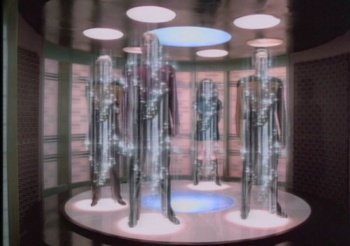Transporters
The transporter is probably the single greatest revolution in the movement of people and goods in recorded history; invented in 2135, the first transporter cleared for for the transport of biological organisms was installed aboard the NX class starship Enterprise in 2151. Although many crewmembers did not trust the new device, with some justification, the transporter eventually became a common feature of 22nd century life.
The basic operating principles of the transporter are relatively simple. It makes a detailed scan of the subject, breaks down its molecular structure, then transmits this beam to another location. The information gained from the scan is then used to reassemble the subject exactly as before.
Like many simple ideas, the actual engineering required to construct a working transporter are quite more complex. A standard transporter unit consists of ten major components :
- Transport Chamber - the area in which the subject is placed for transport; can be of almost any size or shape, though larger chambers have far greater energy requirements and are less efficient for general use
- Operators Console - the control unit of the whole system; typically manned by a single operator who oversees the transport process
- Transporter Controller - a dedicated computer system which controls the minutiae of the transport process
- Primary Energizing Coils - located directly above the transport chamber; generate the annular confinement beam, creating a space-time matrix within which the dematerializing process occurs
- Phase Transition Coils - located in the floor of the transport chamber; cause the actual dematerialisation/materialisation process by decoupling the binding energy between the subatomic particles of the subject, causing the atoms themselves to disintegrate
- Molecular Imaging Scanners - located in the roof of the transport chamber; scan the subject to be transported at quantum resolution, determining the location and momentum of every particle within the subject
- Heisenberg Compensator System - a component of the molecular imaging scanners of all personnel transport systems; transporters built with four redundant sets of scanners, allowing any three to override a fourth should it make an error
- Pattern Buffer - a large super conducting tokamak device, usually situated directly underneath the transporter unit itself ; passed into the pattern buffer and held in suspension while the system compensates for relative motion between itself and the target location; should an emergency arise during transport a pattern can be held suspended in a transport buffer without being either sent or dematerialized
- Biofilter - an image processing device which analyzes the data from the molecular imaging scanner in order to locate any potentially damaging organisms which may have infected the subject
- Emitter Pad Array - mounted on the exterior of the transport system itself - in the case of a spacecraft, on the hull of the ship; transmits the actual matter stream to or from the destination
- Targeting Scanners - a set of redundant sensors which are responsible for determining the exact location of the destination in relation to the transporter unit; also determine the environmental conditions at the target site
A typical operations for Starfleet transporters include the following :
- Beam up involves using the emitter array as the primary energizing coil in order to beam a subject from a remote location which does not have a transporter system.
- Site-to-site transport involves following the conventional beam up process until the subject is in the pattern buffer; the subject is then shunted to a second pattern buffer and on to another emitter array before being beamed out to a new location. This process essentially merges two transport processes in order to allow a subject to be beamed from one location to another without having to rematerialise on board ship first. This process is avoided if possible since it requires double the energy expenditure and system resources to accomplish each transport.
- Hold in pattern buffer. As described, the pattern buffer can be used to hold a subject essentially is stasis. Normally these patterns will degrade after just a few minutes at most, though on one occasion a specially modified transporter held a subject intact for seventy five years.
- Dispersal. Although transporter systems are designed to beam a subject to or from a destination intact, it is possible to override the safety systems on a standard Starfleet transporter and cause it to deliberately disperse the subject over a wide area. This is done by disengaging the annular confinement beam during rematerialization, depriving the subject of a proper reference matrix to form against. Such a measure may be used in order to neutralize a dangerous payload such as a bomb or other weapon; the measure is frequently complemented by materializing the subject in space.
Near warp transport is achieved by careful shifting of the ACB frequency. This can be an uncomfortable experience for those who go through it, and on occasion can even be dangerous.
Warp transport can be achieved by the same method as near warp transport; this is only effective if the origin and destination are moving at the same warp speed. Transport between locations moving with different warp speeds result in a catastrophic loss of pattern integrity - this is fatal to living organisms.
This information is courtesy of the Daystrom Institute Technical Library and copyright Graham Kennedy.
